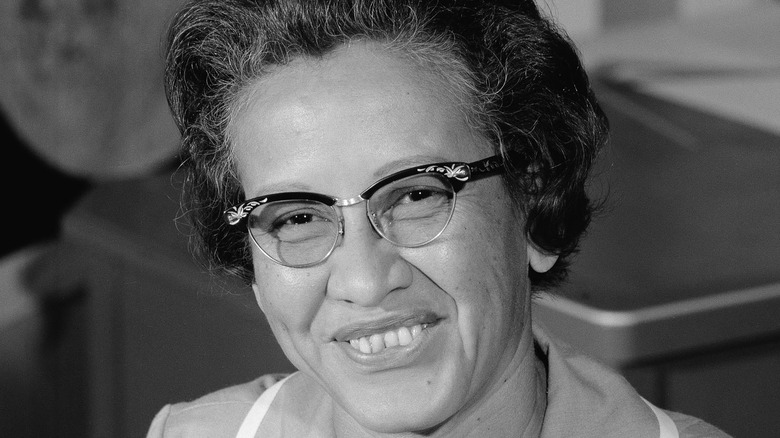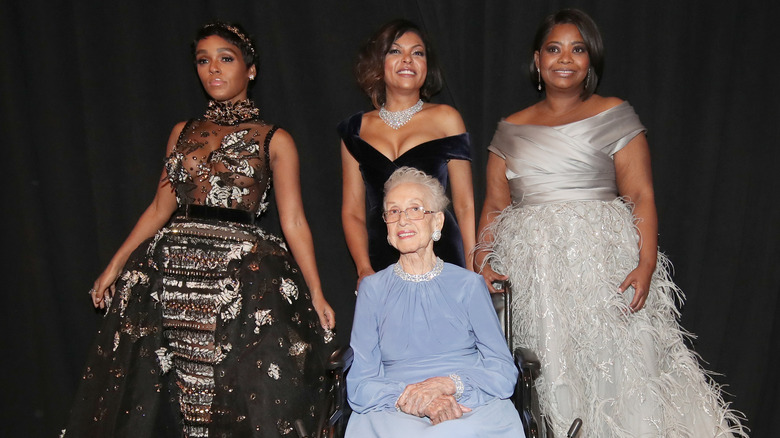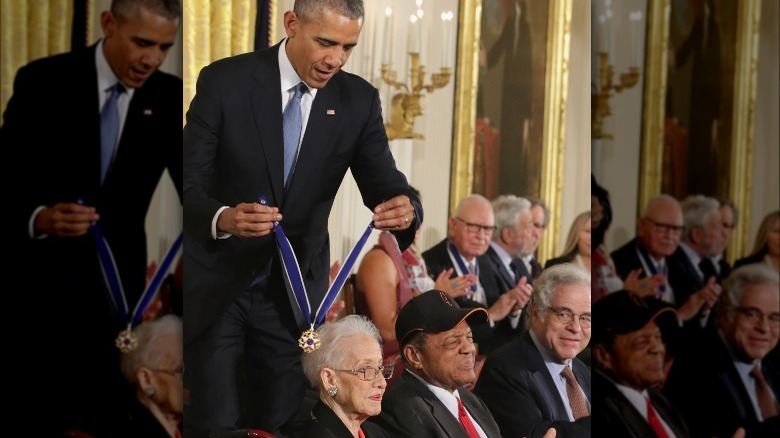How Male NASA Scientists Got Credit For Katherine Johnson's Work
"I did the calculations to put him into orbit." That's Katherine Johnson, talking to AARP about how she helped put astronaut John Glenn into space. If you look at the newspaper articles about the 1962 mission, though, you won't find her name anywhere. But here's what really happened. "NASA began using computers, but [the astronauts] were used to somebody doing the calculations," she explained. "John Glenn said, 'What did the girl get? If she agrees with the computer, then I'll trust the computer.' I was able to work out the calculation several places past the decimal point, and he said OK to the mission."
According to her NASA biography, Johnson was known for her "brilliance with numbers." She started at the National Advisory Committee for Aeronautics in 1953, which eventually became NASA. Johnson worked on a number of ground-breaking space missions, including the first human spaceflight in 1960, Glenn's orbital mission, and the Space Shuttle. As noted on the Katherine Johnson Foundation website, she also worked on the Apollo moon landing — plus five more Apollo flights — and helped develop NASA's first space station.
She retired in 1986, and in her biography, she is quoted as saying, "I loved going to work every single day." Despite her many accomplishments, you probably didn't hear Katherine Johnson's name — or know of her achievements — until actress Taraji P. Henson portrayed her in the 2017 movie "Hidden Figures."
Why you didn't know about her until Hidden Figures
With such important contributions to the United States' growing space program, it's hard to believe Katherine Johnson wasn't a household name during her time at NASA. It wasn't until author Margot Lee Shetterly wrote the book "Hidden Figures" that Johnson's work, along with several others, came to light. "My dad's a NASA research scientist," she told Amsterdam News. "I knew them. I knew they worked with him." Shetterly's book was optioned for the Oscar-nominated movie "Hidden Figures" before it was even finished.
As for why Johnson's achievements were overshadowed by her male colleagues at NASA, Shetterly says there were several factors. "It's complicated," she told Hello Beautiful. "Definitely racism and sexism played a big role in why the story hasn't been told before." She also shared that Johnson did her mathematical calculations in secluded rooms, while the male engineers did more visible work. "Men did the engineering, and the math was seen as a lower form of work," she explained to Culture Trip.
As for Johnson's thoughts on not getting credit at the time of her achievements, her opinion was shared with the Katherine Johnson Foundation. "I certainly never expected any glory. I was just doing the job I was hired to do. I was always proud of my work, but for Pete's sake, I didn't do anything alone."
Katherine Johnson finally got credit, and more
After "Hidden Figures," Katherine Johnson finally received the credit she was due. NASA dedicated a new building to her, The Katherine G. Johnson Computational Research Facility in Hampton, Virginia. Johnson's response to the honor, reported by NASA, was typical of her humble and logical approach. "You want my honest answer? I think they're crazy."
Johnson also had numerous other buildings named after her and received several awards, including the Lunar Spacecraft and Operation's Group Achievement Award from NASA and the Presidential Medal of Freedom (via Katherine Johnson Foundation). During the White House Medal of Freedom Ceremony, broadcast on C-Span, President Barack Obama praised Johnson before awarding her the nation's highest honor for civilians. "In her 33 years at NASA, Katherine was a pioneer who broke the barriers of race and gender, showing generations of young people that everyone can excel in math and science, and reach for the stars."
Upon her death in 2020, NASA administrator James Bridenstine memorialized her in a personal Tweet, captured by Today: "Our @NASA family is sad to learn the news that Katherine Johnson passed away this morning at 101 years old. She was an American hero and her pioneering legacy will never be forgotten." Women at NASA honored her too, tweeting, "Katherine Johnson not only helped calculate the trajectories that took our Apollo astronauts to the Moon — she was [a] champion for women and minorities in the space program and the world as a whole."


